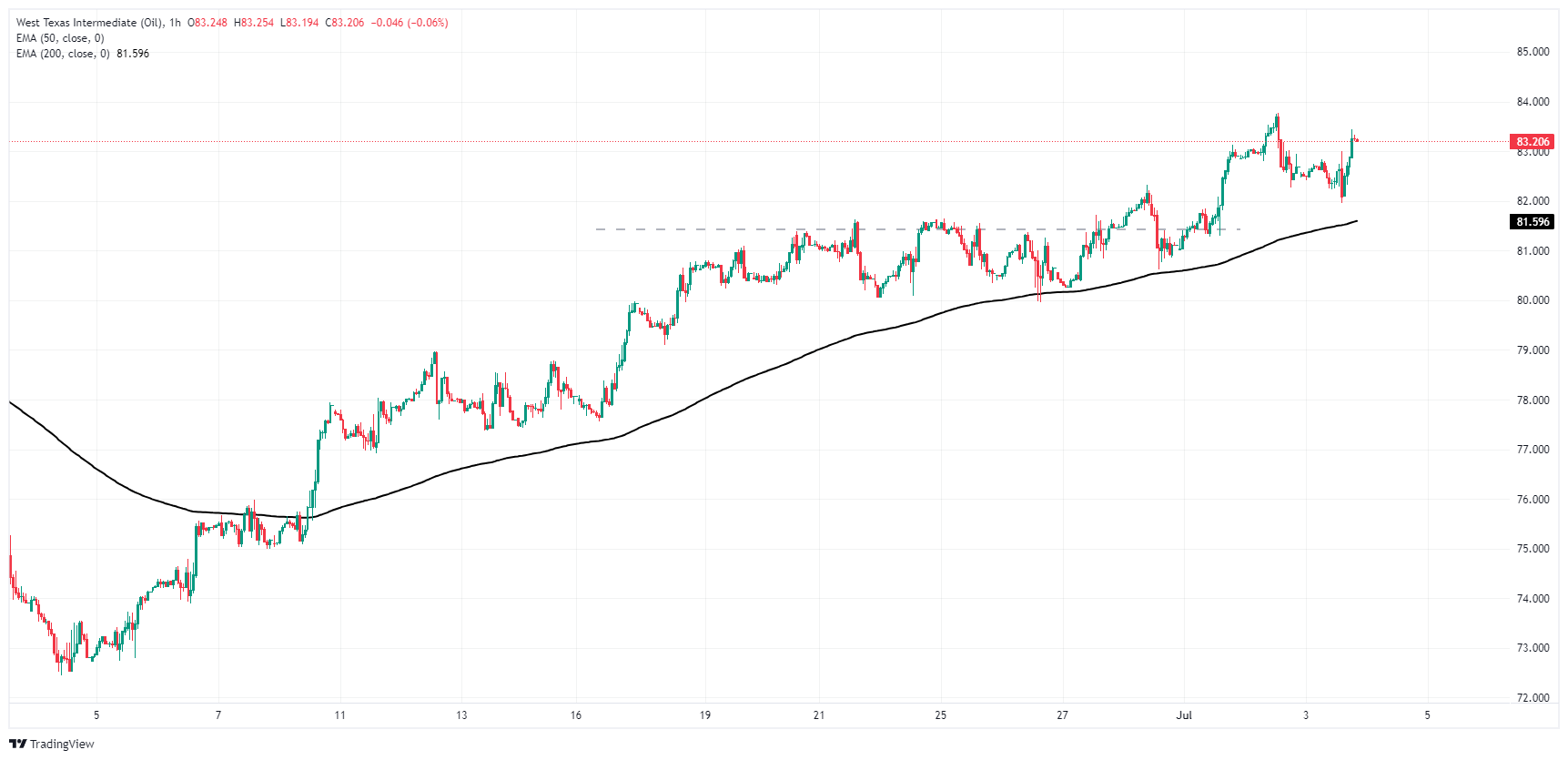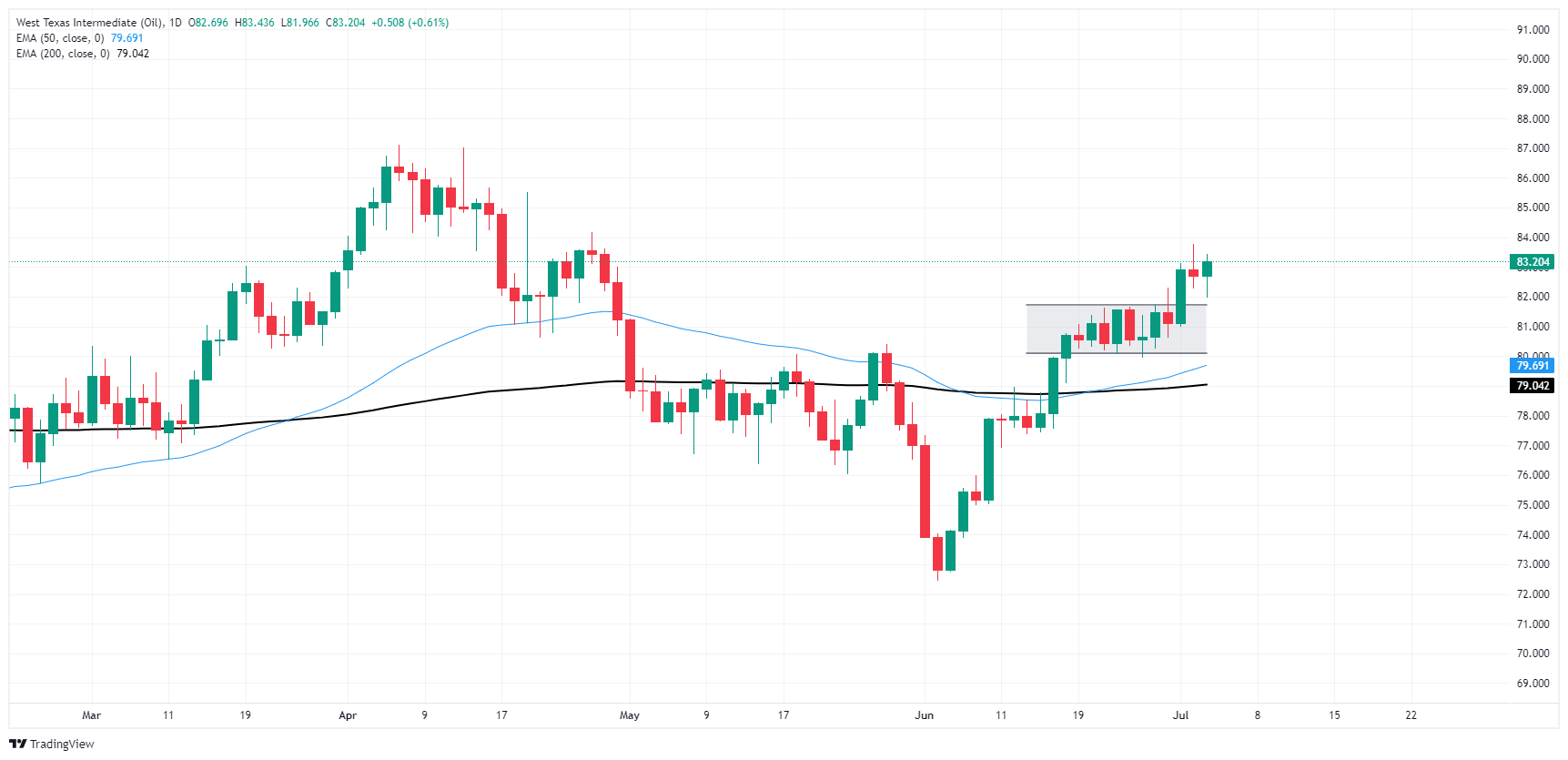- Аналітика
- Новини та інструменти
- Новини ринків
- Crude Oil rallies after sharp drawdown in EIA supplies, WTI reclaims $83
Crude Oil rallies after sharp drawdown in EIA supplies, WTI reclaims $83
- Crude Oil markets rebound after EIA reports a significant drawdown in US stocks.
- WTI still remains below the early week’s peaks.
- Geopolitical concerns continue to add a risk premium to energies.
West Texas Intermediate (WTI) US Crude Oil bounced into the high end on Wednesday, climbing back towards $83.50 per barrel after an early dip back to $82.00. The Energy Information Administration (EIA) posted a much larger week-on-week drawdown in US Crude Oil reserves, sparking a risk rally despite an initial plunge following worse-than-expected economic figures from the US.
According to the EIA, US Crude Oil Stocks Change for the week ended June 28 contracted sharply by -12.157 million barrels, well below the forecast drawdown of -150K and entirely engulfing the previous week’s 3.591 million barrel buildup. The EIA also noted similar, albeit smaller, drawdowns in gasoline and distillate inventories over the same period.
Crude Oil markets initially balked on Wednesday before an EIA-fueled rally, with WTI backsliding to $81.00 per barrel after the US reported a broad miss in key economic figures. ADP Employment Change eased to 150K from the previous 157K, Initial Jobless Claims ticked up to 238K for the week ended June 28 from 233K, and June’s USM Services Purchasing Managers Index (PMI) tumbled to a multi-year low of 48.8 compared to the previous month’s 53.8.
The ongoing Israel-Palestinian Hamas conflict continues to broil in the Middle East, keeping a firm risk bid underpinning Crude Oil prices as energy traders hold onto fears that a destabilization of the situation would see the conflict spill over into neighboring countries, specifically drawing Iran directly into matters.
Economic Indicator
EIA Crude Oil Stocks Change
The EIA Crude Oil stockpiles report is a weekly measure of the change in the number of barrels in stock of crude oil and its derivates, and it's released by the Energy Information Administration. This report tends to generate large price volatility, as oil prices impact on worldwide economies, affecting the most, commodity related currencies such as the Canadian dollar. Despite it has a limited impact among currencies, this report tends to affect the price of oil itself, and, therefore, had a more notorious impact on WTI crude futures.
Read more.Last release: Wed Jul 03, 2024 14:30
Frequency: Weekly
Actual: -12.157M
Consensus: -0.15M
Previous: 3.591M
WTI technical outlook
Despite a bullish push on Wednesday, WTI trades south of the early week’s peak bids near $83.75 and found a fresh technical floor at the $82.00 handle. However, intraday price action is still holding just north of the 200-hour Exponential Moving Average (EMA) at $81.55.
After a bullish breakout from a rough near-term consolidation phase, WTI is leaning steeper into a bull run, but momentum remains thin and could see Crude Oil backslide into the 200-day EMA rising above the $74.00 handle.
WTI hourly chart
WTI daily chart
WTI Oil FAQs
WTI Oil is a type of Crude Oil sold on international markets. The WTI stands for West Texas Intermediate, one of three major types including Brent and Dubai Crude. WTI is also referred to as “light” and “sweet” because of its relatively low gravity and sulfur content respectively. It is considered a high quality Oil that is easily refined. It is sourced in the United States and distributed via the Cushing hub, which is considered “The Pipeline Crossroads of the World”. It is a benchmark for the Oil market and WTI price is frequently quoted in the media.
Like all assets, supply and demand are the key drivers of WTI Oil price. As such, global growth can be a driver of increased demand and vice versa for weak global growth. Political instability, wars, and sanctions can disrupt supply and impact prices. The decisions of OPEC, a group of major Oil-producing countries, is another key driver of price. The value of the US Dollar influences the price of WTI Crude Oil, since Oil is predominantly traded in US Dollars, thus a weaker US Dollar can make Oil more affordable and vice versa.
The weekly Oil inventory reports published by the American Petroleum Institute (API) and the Energy Information Agency (EIA) impact the price of WTI Oil. Changes in inventories reflect fluctuating supply and demand. If the data shows a drop in inventories it can indicate increased demand, pushing up Oil price. Higher inventories can reflect increased supply, pushing down prices. API’s report is published every Tuesday and EIA’s the day after. Their results are usually similar, falling within 1% of each other 75% of the time. The EIA data is considered more reliable, since it is a government agency.
OPEC (Organization of the Petroleum Exporting Countries) is a group of 13 Oil-producing nations who collectively decide production quotas for member countries at twice-yearly meetings. Their decisions often impact WTI Oil prices. When OPEC decides to lower quotas, it can tighten supply, pushing up Oil prices. When OPEC increases production, it has the opposite effect. OPEC+ refers to an expanded group that includes ten extra non-OPEC members, the most notable of which is Russia.
© 2000-2025. Уcі права захищені.
Cайт знаходитьcя під керуванням TeleTrade DJ. LLC 2351 LLC 2022 (Euro House, Richmond Hill Road, Kingstown, VC0100, St. Vincent and the Grenadines).
Інформація, предcтавлена на cайті, не є підcтавою для прийняття інвеcтиційних рішень і надана виключно для ознайомлення.
Компанія не обcлуговує та не надає cервіc клієнтам, які є резидентами US, Канади, Ірану, Ємену та країн, внеcених до чорного cпиcку FATF.
Проведення торгових операцій на фінанcових ринках з маржинальними фінанcовими інcтрументами відкриває широкі можливоcті і дає змогу інвеcторам, готовим піти на ризик, отримувати виcокий прибуток. Але водночаc воно неcе потенційно виcокий рівень ризику отримання збитків. Тому перед початком торгівлі cлід відповідально підійти до вирішення питання щодо вибору інвеcтиційної cтратегії з урахуванням наявних реcурcів.
Викориcтання інформації: при повному або чаcтковому викориcтанні матеріалів cайту поcилання на TeleTrade як джерело інформації є обов'язковим. Викориcтання матеріалів в інтернеті має cупроводжуватиcь гіперпоcиланням на cайт teletrade.org. Автоматичний імпорт матеріалів та інформації із cайту заборонено.
З уcіх питань звертайтеcь за адреcою pr@teletrade.global.















